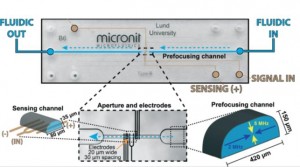Groups collaborating across Sweden, Denmark, and Korea develop a chip-integrated acoustic focusing technique to precisely arrange particles for fast sizing and counting using impedance analysis.
The size and number of particles in a mixture can be quickly determined using a Coulter counter. Changes in resistance across a Coulter counter orifice through which particles pass correspond to the volume particles occupy as they displace the ionic carrier fluid (impedance spectroscopy). As fabrication methods transition to planar electrode formats to facilitate device development, the precise position of particles in the orifice becomes crucial to obtaining accurate results. Using planar electrodes on the channel bottom, the electric field across the orifice varies and thus sizing information from amplitude changes in impedance depend on consistent particle positioning. Previous methods using fluid flow focusing require complex fabrication steps and suffer from ion diffusion between virtual channel boundaries (fluid-fluid interfaces). Thus, Carl Grenvall in the Biomedical Engineering department in Lund University and his colleagues developed an acoustic actuation method to focus particles into the middle of the channel before they pass into the sensing aperture containing planar electrodes.
The team used two different frequencies to form standing waves in horizontal and vertical directions of the ‘prefocusing channel’ to guide particles to the center of the aperture where impedance was analyzed. Concentration studies helped determine the optimal density of particles to enable rapid sample analysis yet prevent formation of doublets. Confocal imaging confirmed simulation results to show distribution of focused particles and narrow confinement – 2.04% coefficient of variation after removing doublets, which is on par with other experimental and commercial cytometry platforms. The group was able to discriminate particle sizes from 3, 5, and 7 μm as well as separate 7 μm beads in a diluted blood sample. This demonstration of efficient particle focusing in two dimensions is an exciting development to create integrated simple-to-manufacture microchip impedance microscopy platforms. Standing wave acoustophoresis is gentle on cells as several studies even reporting in-field cell culturing1, thus suggesting further opportunities for integration of microscale cytometers into microscale experimental platforms.
Download the full paper for free* for a limited time only!
Two-dimensional acoustic particle focusing enables sheathless chip Coulter counter with planar electrode configuration
Carl Grenvall, Christian Antfolk, Christer Zoffmann Bisgaard, and Thomas Laurell. Lab Chip, 2014, 14, 4629 – 4637.
DOI: 10.1039/c4lc00982g
*Access is free through a registered publishing personal account until 03/02/2015.
[1] M. A. Burguillos, C. Magnusson, M. Nordin, A. Lenshof, P. Augustsson, M. J. Hansson, E. Elmer, H. Lilja, P. Brundin and T. Laurell, PloS one, 2013, 8, e64233.











